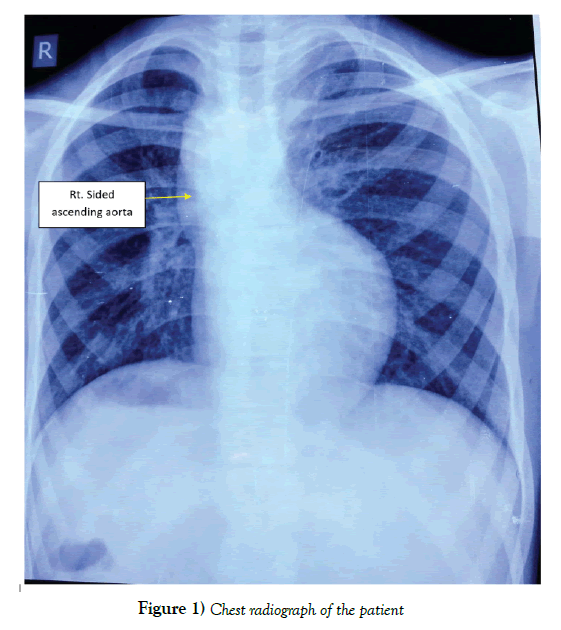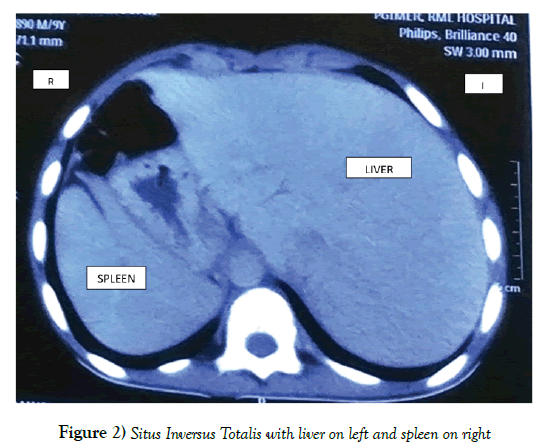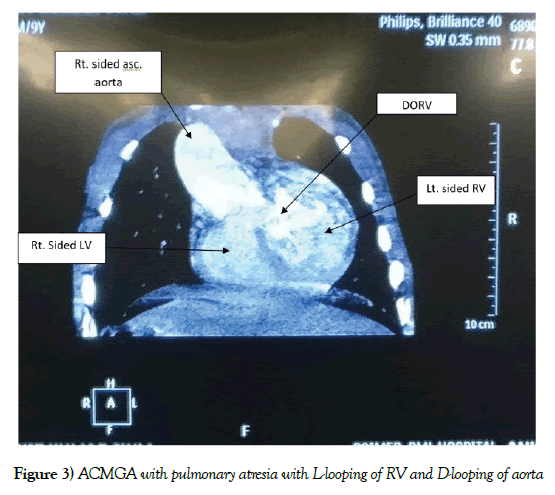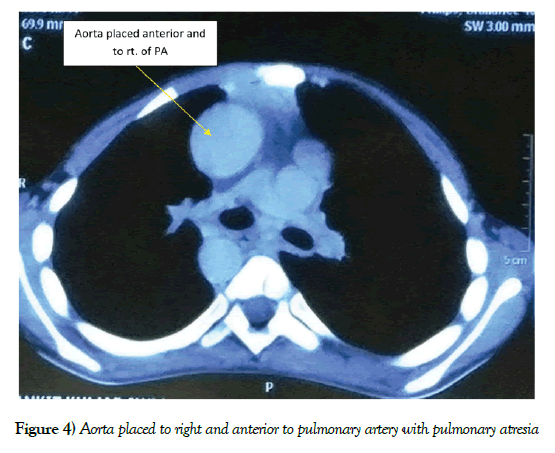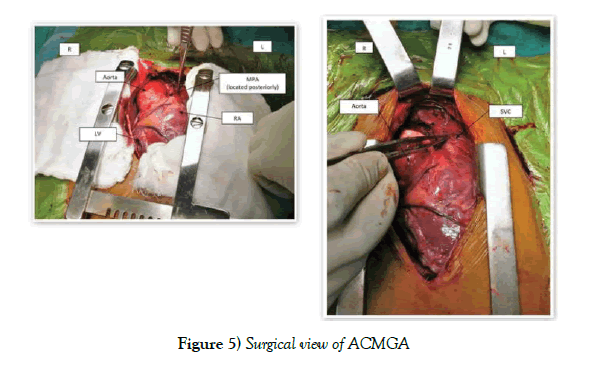Anatomically corrected malposition of great arteries-{I,L,D} type :First contact
Received: 05-Oct-2017 Accepted Date: Nov 21, 2017; Published: 25-Nov-2017
Citation: Guha S, Bhagwan J, Gupta VK. Anatomically corrected malposition of great arteries–{I,L,D} type: First contact. Int J Anat Var. 2017;10(S1):81-2.
This open-access article is distributed under the terms of the Creative Commons Attribution Non-Commercial License (CC BY-NC) (http://creativecommons.org/licenses/by-nc/4.0/), which permits reuse, distribution and reproduction of the article, provided that the original work is properly cited and the reuse is restricted to noncommercial purposes. For commercial reuse, contact reprints@pulsus.com
Abstract
Anatomically Corrected Malposition of the Great Arteries (ACMGA) is a rare congenital heart disease in which the great arteries are abnormally related to each other and to the ventricles, but arise nonetheless above the anatomically correct ventricles. There are 4 types of ACMGA: Type 1 (S,D,L)-situs solitus, d-loop ventricles, left and anterior aorta; Type 2 (S,L,D)-situs solitus, l-loop ventricles, right and anterior aorta; Type 3 (I,L,D)-situs inversus, l-loop ventricles, right and anterior aorta; and Type 4 (I,D,L)-situs inversus, d-loop ventricles, left and anterior aorta. The existence of I,L,D type has been theorized but not demonstrated in a patient till date. We report a case of ACMGA type (I,L,D) in a 9 year old child. To our knowledge this is the first case of ACMGA (type I,L,D) reported in literature so far.
Keywords
Aorta; Ventricles; Hypoplasia
Abbreviations
VSD Ventricular septal defect; ASD Atrial septal defect; ACMGA Anatomically corrected malposition of the great arteries
Case Report
A 9 year old male child presented to us with recurrent cyanotic spells. His chest radiograph revealed a tubular shaped heart more towards the left and the ascending aorta shadow more towards the right (Figure 1). Cardiac CT showed the extremely unique finding of Situs Inversus Totalis with AVVA concordance with L-looping of right ventricle and D-looping of Aorta- Van Praagh {I,L,D} (Figures 2-4). Other findings included pulmonary atresia with sub-aortic VSD and Os ASD. Large MAPCAs were present. Aortic root was rotated with LCA from anterior coronary sinus and RCA from posterior coronary sinus. A diagnoses of anatomically corrected malposed great arteries (type-I,L,D) with pulmonary atresia was made (Figure 5). The child subsequently underwent a central shunt in view of recurrent spells with small branch PAs. The child has been doing well in follow-up.
Figure 2) Situs Inversus Totalis with liver on left and spleen on right
Discussion and Conclusion
Anatomically Corrected Malposition of the Great Arteries (ACMGA) is a rare congenital heart disease in which the great arteries are abnormally related to each other and to the ventricles, but arise nonetheless above the anatomically correct ventricles. In other words, the transposition of the great arteries is not present and the great arteries are normally connected to their appropriate ventricles. The abnormality lies in the inter-arterial relationship which is of parallel vessels.
This abnormal relationship was first reported in 1895 by Theremin and was characterized by Van Praagh et al later in 1975 [1]. There are 4 types of ACMGA: Type 1 (S,D,L)–situs solitus, d-loop ventricles, left and anterior aorta; Type 2 (S,L,D)–situs solitus, l-loop ventricles, right and anterior aorta; Type 3 (I,L,D)–situs inversus, l-loop ventricles, right and anterior aorta; and Type 4 (I,D,L)–situs inversus, d-loop ventricles, left and anterior aorta [2]. In the absence of associated malformations, anatomically corrected malposition is associated with normal physiology and may be detected incidentally. The clinical presentation and findings in these patients depend upon the type and severity of associated anomalies. The associated abnormalities can be juxtaposed atrial appendages, tricuspid atresia in ventricular septal defects, arch hypoplasia, coarctation of aorta, tetralogy of fallot [3,4].
In normal hearts, the great vessels are oriented such that the pulmonary artery is superior, left and anterior due to the persistence and continued growth of subpulmonary conus, and the aorta is posterior, inferior and right to the pulmonary artery [5] due to the absorption of the subaortic conus.
Thus, the right ventricular outflow tract crosses the aorta anteriorly connected to the pulmonary artery, and the absorption of the subaortic conus connects the aorta to the left ventricle and mitral-aortic continuity. The most important mechanism which normally brings the aorta posterior and above the left ventricle is an 800-1100 counter-clockwise rotation of the cono-truncus [6].
Over-rotation of the cono-truncus in L-loop ventricles leads to D-malposition, and over-rotation in D-loop ventricles leads to L-malposition types of ACMGA. It is possible to misdiagnose this condition with DORV or TGA which are associated with malposition of great arteries. The existence of I,L,D type of ACMGA has been theorized but not demonstrated in a patient till date. We hope to add to the existing literature with this first of its kind image report of ACMGA type {I,L,D}.
REFERENCES
- Van Praagh R, Durnin RE, Jockin H, et al. Anatomically corrected malposition of the great arteries. Circulation. 1975;51:20-31.
- Sridhar A, Subramanyan R, Verma S, et al. Anatomically corrected malposition of great arteries. Annal Pediatric Cardiol. 2010;3:187-9.
- Anderson RH, Becker AE, Losekoot TG, et al. Anatomically corrected malposition of great arteries. Br Heart J. 1975;37:993-1013.
- Freedom R, Harrington DP. Anatomically corrected Malposition of the great arteries Report of 2 cases, one with congenital asplenia frequent association with juxtaposition of atrial appendages. Br Heart J. 1974;36:207-15.
- Van Praagh R, Van Praagh S. Anatomically corrected transposition of the great arteries. Br Heart J. 1976;29:112-9.
- Goor DA, Dische R, Lellihei CW. The cono truncus I its normal inversion and absorption. Circulation. 1972;46:375-84.




